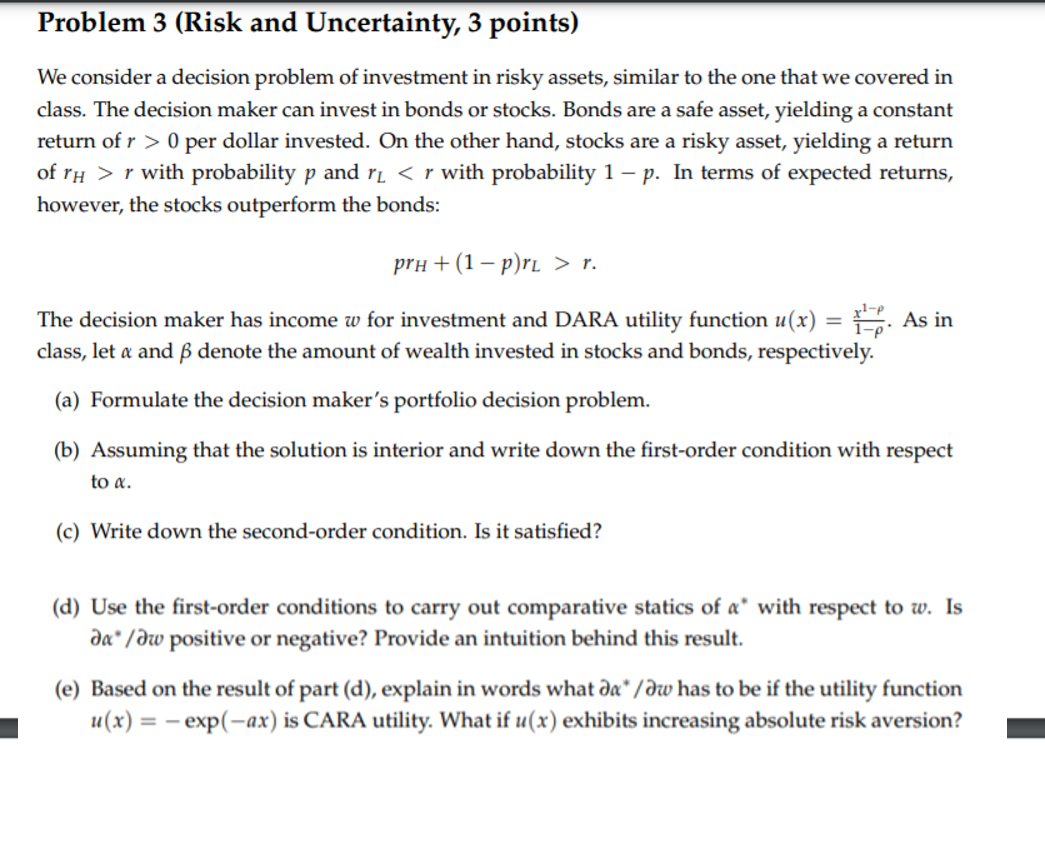Answered step by step
Verified Expert Solution
Question
1 Approved Answer
it is complete Problem 3 (Risk and Uncertainty, 3 points) We consider a decision problem of investment in risky assets, similar to the one that

it is complete
Problem 3 (Risk and Uncertainty, 3 points) We consider a decision problem of investment in risky assets, similar to the one that we covered in class. The decision maker can invest in bonds or stocks. Bonds are a safe asset, yielding a constant return of r > 0 per dollar invested. On the other hand, stocks are a risky asset, yielding a return of rh > r with probability p and r1 r. a The decision maker has income w for investment and DARA utility function u(x) = 1**. As in class, let & and denote the amount of wealth invested in stocks and bonds, respectively. (a) Formulate the decision maker's portfolio decision problem. (b) Assuming that the solution is interior and write down the first-order condition with respect to a. (c) Write down the second-order condition. Is it satisfied? (d) Use the first-order conditions to carry out comparative statics of a* with respect to w. Is a* /dw positive or negative? Provide an intuition behind this result. (e) Based on the result of part (d), explain in words what da* /aw has to be if the utility function u(x) = - exp(-ax) is CARA utility. What if u(x) exhibits increasing absolute risk aversion? Problem 3 (Risk and Uncertainty, 3 points) We consider a decision problem of investment in risky assets, similar to the one that we covered in class. The decision maker can invest in bonds or stocks. Bonds are a safe asset, yielding a constant return of r > 0 per dollar invested. On the other hand, stocks are a risky asset, yielding a return of rh > r with probability p and r1 r. a The decision maker has income w for investment and DARA utility function u(x) = 1**. As in class, let & and denote the amount of wealth invested in stocks and bonds, respectively. (a) Formulate the decision maker's portfolio decision problem. (b) Assuming that the solution is interior and write down the first-order condition with respect to a. (c) Write down the second-order condition. Is it satisfied? (d) Use the first-order conditions to carry out comparative statics of a* with respect to w. Is a* /dw positive or negative? Provide an intuition behind this result. (e) Based on the result of part (d), explain in words what da* /aw has to be if the utility function u(x) = - exp(-ax) is CARA utility. What if u(x) exhibits increasing absolute risk aversion Step by Step Solution
There are 3 Steps involved in it
Step: 1

Get Instant Access to Expert-Tailored Solutions
See step-by-step solutions with expert insights and AI powered tools for academic success
Step: 2

Step: 3

Ace Your Homework with AI
Get the answers you need in no time with our AI-driven, step-by-step assistance
Get Started


